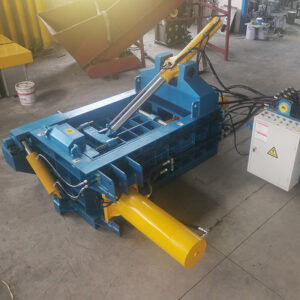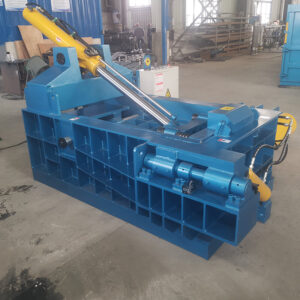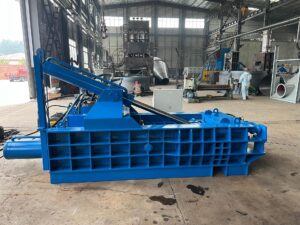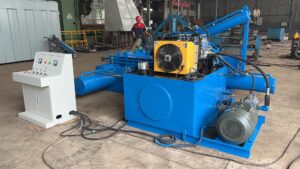Tired of mountains of scrap metal devouring your warehouse space? Imagine transforming chaotic piles of loose scrap into compact, stackable bales – reducing volume by up to 90% and instantly freeing up valuable floor space. This isn’t just a dream; it’s the daily reality for modern recycling operations powered by Horizontal Metal Balers.
Why Horizontal Metal Balers Dominate Industrial Recycling:

Horizontal balers aren’t just machines; they’re strategic assets delivering measurable ROI:
-
Space Liberation: Reduce scrap volume by 10:1, reclaiming critical square footage.
-
Transpo
-
rtation Savings: Compact bales mean fewer truckloads (up to 50% less).
-
Value Maximization: Deliver denser, contaminant-free bales that command premium prices.
-
Safety Transformation: Automate hazardous manual handling tasks.
-
Efficiency Surge: Process tons per hour with minimal labor input.
Deep Dive: The Anatomy of a High-Performance Horizontal Metal Baler
Understanding the core components reveals w
hy quality engineering matters:
-
The Heart: Hydraulic Power Unit (HPU)
-
Oil Pump: High-pressure gear pumps (e.g., Rexroth, Parker) deliver the relentless force needed (often 3000+ PSI). Reliability here is non-negotiable.
-
Power (KW): Ranges from 22KW for compact models to 150KW+ for giants handling structural steel. Direct correlation to bale density and speed.
-
Cooling: Essential for sustained operation. Air-Cooled systems offer simplicity, while large industrial balers often use Cooling Towers for closed-loop water cooling efficiency. Look for oversized coolers.
-
Valves & Controls: Precision electro-hydraulic valves dictate cylinder movement speed and sequence. Proportional valves enable smooth, powerful compaction.
-
-
The Muscle: Cylinders & Structure
-
Main Compression Cylinder: Generates the primary crushing force. Diameter (盖缸直径) directly impacts force (Force = Pressure x Area). Massive cylinders (300mm+ diameter common) deliver 200+ tons of force.
-
Feed Cylinder / Pusher Plate: Forces material into the compression chamber. 后推缸直径 determines feed power and stroke length.
-
Side Thrust Cylinders (Optional): Enhance density on wide chambers by compacting material sideways.
-
Bale Ejector / Door Cylinders: Powerfully eject the finished bale and secure the charging door.
-
Structural Integrity: 侧杠直径 (Side Beam Diameter) is critical. Heavy-duty box-section beams (often 400mm x 400mm+) resist immense bending forces. High-tensile steel plates (板厚规格 – 25mm+ common) form the robust chamber.
-
-
The Workflow: Chamber & Charging
-
料箱尺寸 (Hopper Size): Dictates maximum charge volume and material type suitability. Larger hoppers handle bulky items (e.g., appliances, auto bodies).
-
Chamber Dimensions: Defines 包块尺寸 (Bale Size). Standard sizes exist (e.g., 1100x700mm, 1200x800mm), but custom chambers are common. Liner plates protect against wear.
-
Door Mechanisms: Heavy-duty, interlocked doors ensure operator safety during compression. Hydraulic latching is standard.
-
-
The Brain: Control System
-
PLC (Programmable Logic Controller): The central nervous system. Modern PLCs (Siemens, Allen-Bradley, Omron) manage the entire cycle: feeding, compression, strapping (if integrated), ejection.
-
HMI (Human-Machine Interface): Color touchscreens provide intuitive operation, cycle monitoring, diagnostics, and data logging (tons processed, cycles per hour).
-
Remote Control: 遥控 (Remote Control) capability, especially Wireless Remote Control, is crucial for operator safety, allowing control away from the noisy, potentially hazardous loading area. Enables efficient material feeding from multiple angles.
-
-
Essential Features & Options
-
Shearing: 侧刀 (Side Knife / Side Cutter) – Hydraulic side knives integrated into the chamber walls (Built-in Side Cutter) slice long, tangled scrap (wiring harnesses, rebar) during compression for denser bales.
-
Bale Tying: Automatic wire-tying systems (2-8 wires) secure bales instantly after compression. Polyester strapping options exist.
-
Dust Suppression: Water spray systems minimize dust during compaction (crucial for aluminum, cast).
-
Conveyor Integration: Vibrating or belt conveyors feed loose scrap efficiently into the hopper.
-
Machine Weight: Indicates robustness. Small units start around 8 tons; large industrial balers exceed 40 tons. 外形尺寸 (Overall Dimensions) must fit your facility layout, including overhead clearance for feeding.
-
Horizontal vs. Vertical Balers: Choosing the Champion

-
Volume & Density: Horizontal balers are undisputed kings for high-volume processing (tons per hour) and achieving maximum bale density (essential for maximizing scrap value, especially with non-ferrous metals).
-
Material Handling: Horizontals effortlessly handle large, bulky, and long scrap pieces (car bodies, appliances, demolition steel) that would jam a vertical baler.
-
Automation: Horizontal balers more readily integrate fully automated feeding and bale handling systems.
-
Footprint: While generally larger (外形尺寸), their efficiency per square foot often surpasses needing multiple vertical balers.
-
Cost: Horizontal balers represent a significantly larger capital investment but deliver a vastly higher ROI for serious scrap processors.
Applications: Where Horizontal Balers Shine
-
Ferrous Scrap Yards: Processing shredded steel, HMS 1 & 2, turnings, demolition scrap, auto bodies into mill-grade bundles.
-
Non-Ferrous Recovery: Creating high-density bales of UBCs (Used Beverage Cans), extrusion scrap, cast aluminum, copper wire, brass turnings – maximizing value per load.
-
White Goods & Appliance Recycling: Efficiently crushing and baling refrigerators, washers, dryers after degassing.
-
Automotive Shredder Residue (ASR): Further volume reduction of fluff post-shredding.
-
Industrial Manufacturing: Capturing and baling stamping skeletons, turnings, offcuts directly at the source.
Maximizing Your Investment: Operation & Maintenance

-
Trained Operators: Essential for safety and efficiency. Training should cover controls, emergency stops, lockout/tagout (LOTO), and recognizing jams.
-
Preventive Maintenance (PM): The key to longevity and uptime:
-
Daily: Visual inspections, check hydraulic oil level/cooler, listen for unusual noises, clean around the machine.
-
Weekly: Check cylinder mounts, structural bolts, hose condition.
-
Monthly: Sample and analyze hydraulic fluid, grease all bearings, inspect electrical connections.
-
Annually: Thorough inspection of cylinders (seals, rods), valves, pumps, structural welds; replace hydraulic filters and fluid as needed.
-
-
Hydraulic Fluid Care: Maintain cleanliness (filtration) and correct temperature (Cooling system critical). Monitor for contamination (water, metal particles).
-
Wear Parts Management: Stock critical wear items (seal kits for key cylinders, filter elements, hydraulic hoses, cutter blades).
Safety: The Non-Negotiable Priority
Horizontal balers exert immense force. Safety is paramount:
-
Comprehensive Guarding: Fixed guards around all moving parts (cylinders, doors, shears).
-
Safety Interlocks: Prevent the door from opening or the main cylinder from moving unless conditions are safe. Light curtains or pressure mats at the charging door.
-
Emergency Stops: Multiple, easily accessible E-Stop buttons, including on the Remote Control.
-
LOTO Procedures: Strict adherence to Lockout/Tagout before any maintenance or clearing jams.
-
Operator Training: Continuous reinforcement of safety protocols.
The Future of Horizontal Metal Balers: Smarter & Greener

-
IoT & Connectivity: Real-time monitoring of performance metrics (cycles, tonnage, pressure, temperature), predictive maintenance alerts, remote diagnostics.
-
Energy Efficiency: Variable speed drives (VSDs) on hydraulic pumps significantly reduce power consumption (Power (KW) demand during idle/low load).
-
Advanced Controls: AI-powered optimization of compression cycles based on material type, auto-adjustment for maximum density with minimal energy.
-
Enhanced Automation: Robotic feeding and bale handling integration becoming more common.
-
Material Recognition: Sensors identifying material types for automatic cycle selection and sorting potential.
Choosing the Right Horizontal Baler: Key Considerations
-
Material Types & Volumes: What scrap do you process? How many tons per day/week?
-
Required Bale Size & Density: What are your customers’/mills’ specifications? (包块尺寸)
-
Available Space: Carefully measure (外形尺寸 including height for feeding).
-
Power & Utilities: Ensure adequate electrical supply (Power (KW)) and consider cooling needs (Air-Cooled vs. Cooling Tower).
-
Automation Level: Need conveyors, auto-tying, Remote Control? Built-in Side Cutter?
-
Budget: Consider TCO (Total Cost of Ownership) – purchase price, installation, operation (power), maintenance.
-
Manufacturer Reputation & Support: Look for proven engineering, quality construction (check 板厚规格, 侧杠直径, component brands), and responsive local service/support.
Conclusion: The Engine of Recycling Profitability
The horizontal metal baler is far more than a piece of heavy machinery; it’s the cornerstone of a profitable, efficient, and safe modern scrap recycling operation. By transforming waste into a valuable, transportable commodity, it directly boosts your bottom line while contributing significantly to environmental sustainability through resource conservation and reduced landfill dependence.
Investing in the right horizontal baler – one engineered with robust components (powerful 油泵, substantial 盖缸直径/后推缸直径, heavy 板厚规格 beams), equipped with essential features (Built-in Side Cutter, efficient Cooling, Remote Control), and backed by strong support – is an investment in the future resilience and growth of your business.
Ready to Transform Your Scrap Metal Operation?
-
Download Our Detailed Baler Specification Guide: Compare models, capacities, and features side-by-side.
-
Request a Free Site Assessment: Our experts will evaluate your needs and recommend the optimal solution.
-
Watch Our Baler in Action: See the power and efficiency firsthand in our video gallery.
-
Contact Us for a Personalized Quote: Discover the ROI a horizontal baler can deliver for your business.
Unlock the power of compaction. Maximize your scrap value. Contact us today!
